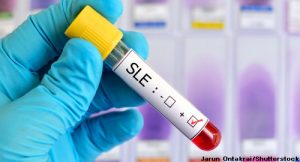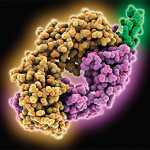 For patients with difficult-to-treat systemic lupus erythematosus (SLE), regular treatment with rituximab may offer a way to maintain disease remission, according to research published in Arthritis & Rheumatology.1 Patients with severe disease localization, in particular, may benefit from rituximab maintenance therapy if traditional therapy, such as glucocorticoids and methotrexate, is ineffective or not well tolerated, or if other licensed biologics are unavailable or not indicated.
For patients with difficult-to-treat systemic lupus erythematosus (SLE), regular treatment with rituximab may offer a way to maintain disease remission, according to research published in Arthritis & Rheumatology.1 Patients with severe disease localization, in particular, may benefit from rituximab maintenance therapy if traditional therapy, such as glucocorticoids and methotrexate, is ineffective or not well tolerated, or if other licensed biologics are unavailable or not indicated.
The study from Cassia et al. examined the efficacy and safety of rituximab in SLE patients, with a particular focus on a subgroup of patients treated with maintenance rituximab to prevent relapse.
“Our study is the first focusing on a cohort of SLE patients treated with rituximab-based maintenance treatment with the aim of relapse prevention,” says Federico Alberici, MD, PhD, associate professor-consultant in Renal Medicine University of Brescia, Brescia, Italy, and the study’s corresponding author and coordinator.
Dr. Alberici emphasized the need to improve remission in SLE patients as a key phase of disease management, as well as the need to find an effective maintenance therapy to achieve this outcome. Traditional drugs, he says, may provide some disease control, but flares remain common. Although biologic therapy, in particular belimumab, is effective at controlling flares in subsets of SLE patients with mucocutaneous and articular involvement, belimumab is not currently indicated for patients with active, severe, disease localization.
In the study, the researchers retrospectively assessed the efficacy and safety of rituximab in 147 SLE patients at four centers. Sixty-seven of the 147 patients were treated with a single course of rituximab, receiving their doses within a single month given two weeks apart or over four consecutive weeks. Eighty patients were treated with rituximab maintenance therapy, receiving at least three single-rituximab courses, with an interval of four to eight months between consecutive treatment courses. Patients were stratified into four groups based on disease severity at baseline: mild, moderate, severe and drug sparing. The drug-sparing group included patients for whom rituximab was being used to reduce exposure to other drugs with an unfavorable balance of potential benefits and toxicity.
To assess disease activity, the investigators used the European Consensus Lupus Activity Measurement (ECLAM) and the physician’s assessment (i.e., 0 = no sign of active SLE, 1 = mild disease activity and 2 = severe disease activity). They also measured changes in the immunosuppressive drugs used by patients in association with rituximab.
Response to the first course of rituximab was assessed after six months. The study defined a complete response as a physician’s assessment score of 0 or 1, a reduction of at least 50% in ECLAM score and at a least 25% decrease from baseline in immune-modulating therapy dosage. A partial response was defined as a physician’s assessment score greater than 0, a 25–50% reduction in ECLAM score and a 0–25% reduction in immune-modulating therapy dosage. Any other response was defined as treatment failure.
Rituximab as Maintenance Therapy
The 80 patients on rituximab maintenance therapy had a median treatment duration of 24 months (range: 11–99 months), a median rituximab dose of 6 gm and a median follow up of 38 months. Table 1 lists disease and treatment characteristics after the first rituximab administration and after six months of rituximab maintenance therapy.
| Table 1 | ||
|
After First Rituximab Administration |
After 6 months on Rituximab Maintenance Therapy |
|
| Percentage of patients on prednisolone or immunosuppressive drugs |
|
|
| Mean ECLAM score |
3.5 |
1.86* |
| Treatment response |
|
30 (38%) had complete response, increasing to 48% at 24 months |
| *Significant decrease from 3.5 (P<0.0001) | ||
In the subgroup of 80 patients treated with rituximab maintenance therapy, 52 patients (65%) experienced 85 relapses at a median of 11.5 months. The most frequent sites of disease flare were in the joints (66% of patients) and skin (40% of patients). A total of 67 patients (84%) were in remission at the time of the last administration of rituximab.
Overall, 28 of 80 patients (35%) did not experience flare during the maintenance treatment and were considered sustained responders. In a multivariate analysis, the presence of active articular disease at the time of first rituximab administration was associated with the risk of flare during rituximab maintenance therapy after adjusting for disease severity.
“Apparently, a rituximab-based maintenance approach is not very effective in controlling musculoskeletal reactivations of the disease, and articular flares may occur during treatment,” says Dr. Alberici.
When looking at outcomes after the last rituximab infusion, data were available for 57 of the 80 patients (71%). At a median follow-up of 13 months from the last rituximab administration, 30 of these 57 patients (53%) experienced flares. The rate of flares involving major organs, particularly neurologic, pulmonary and hematologic flares, significantly increased after maintenance rituximab was withdrawn (67% vs. 38%; P=0.01). Additionally, no difference was observed in the median relapse-free survival after the last rituximab infusion between patients treated with a single course of rituximab and those treated with maintenance rituximab (16 and 17 months, respectively; P=0.72)
Dr. Alberici emphasizes the effects of maintenance rituximab were not sustained, with the relapse risk similar to that found in the patients treated with a single course of rituximab. He says this suggests a lack of impact on the long-term disease outcome or on the disease biology itself. He thinks this finding is particularly interesting considering that a rituximab-based maintenance regimen seems to prolong the post-treatment, relapse-free survival in anti-neutrophil cytoplasmic antibody (ANCA) associated vasculitis.
“At rituximab withdrawal, doctors should be aware that the relapse rate is significant and patients should be monitored closely,” he says. “The lack of sustained beneficial effects in terms of relapse-free survival is mainly due to musculoskeletal flares, although when considering only other organs, a trend for a longer relapse-free survival after rituximab maintenance treatment is observed compared with a single [course of] rituximab administration.”
Commenting on the study, David Isenberg, MD, professor of Rheumatology, Centre for Rheumatology, University of College London, says, “The study offers the possibility that, for some SLE patients, regular, repeated dosing with rituximab may be beneficial.” However, he also expresses some concerns.
“Unlike rheumatoid arthritis, SLE is a disease that often ‘waxes and wanes.’ In my personal experience of having treated 170 SLE patients in a single center, I have not really been convinced of the relatively expensive need to treat SLE patients with regular rituximab,” he says. “My own experience is that rituximab—with some intravenous steroid and on occasions intravenous cyclophosphamide—can get many patients into remission, which can be maintained with more conventional, less expensive drugs, such as hydroxychloroquine, low-dose steroids or azathioprine or methotrexate.”
Dr. Isenberg emphasizes the findings suggest rituximab may be given on a regular basis with “good effect,” but “careful patient selection is vital.” In particular, he notes, patients with falling immunoglobulin levels who are at increased risk of infection would not be good candidates for rituximab maintenance nor, obviously, patients who do not respond to rituximab.
Predictive Factors of Positive Response to Single-Rituximab Course
The study identified factors predictive of a positive response to a single course of rituximab. “We have identified C4 levels and lower number of previous immunosuppressive drugs employed as factors associated with a positive response,” says Dr. Alberici.
At six months after the first administration of rituximab, 67 patients (45%) had a complete response, 41 (28%) had a partial response and 39 (27%) experienced treatment failure. Patients with more severe disease were more likely to respond to rituximab. According to the authors, this finding suggests patients with more active disease and without a clear refractory course of disease may be the best candidates for rituximab.
The study found the proportion of treatment failure decreased as the severity of disease increased, with 65% treatment failure for mild disease severity, 50% for moderate disease severity, 25% for severe disease and 6% for drug sparing). When adjusting for confounding factors, such as treatment with immunosuppressive drugs and prednisolone dose, the study found patients with higher C4 levels and those who had used more than four immunosuppressive agents in the past had a higher risk of experiencing treatment failure.
Mary Beth Nierengarten is a freelance medical journalist based in Minneapolis.
Reference
- Cassia MA, Alberici F, Jones RB, et al. Rituximab as maintenance treatment for systemic lupus erythematosus: A multicenter observational study of 147 patients. Arthritis Rheumatol. 2019 Oct;71(10):1670–1680. Epub 2019 Aug 30.



